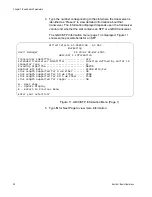
AT-S63 Management Software Menus User’s Guide
Section I: Basic Operations
53
Subnet Mask
Subnet mask of the local interface.
Gateway
For AT-9400 Switches that support IPv4 routing, such as the
AT-9424Ts and AT-9448Ts/XP switches, this field displays the IP
address of the next hop of the switch’s default route. The switch uses
the default route when it receives a network packet for routing, but
cannot find a route for it in the routing table. This field will contain
0.0.0.0 if no default route is defined on the switch.
For AT-9400 Switches that do not support IPv4 packet routing, such as
the AT-9424T/GB and AT-9424T/SP switches, this field displays the
default gateway address. This is the IP address of a router interface on
your network. It represents the next hop to reaching a remote network
device, such as a remote management workstation or a syslog server,
when the switch’s local interface and the remote device are on different
subnets. The default value is 0.0.0.0.
Note
For instructions on how to configure the routing interfaces on the
switch, including the local interface, refer to Chapter 29, “Internet
Protocol Version 4 Routing Interfaces” on page 547.
System Up Time
The number of days, hours, minutes, and seconds the switch has been
operational. You cannot change this setting.
Bootloader and Build Date
The version of the bootloader software and the date it was built.
Application and Build Date
The version of the AT-S63 Management Software that the switch is
currently running and the date it was built.
System Name
The name of the switch.
Administrator
The administrator of the switch.
Location
The location of the switch.
Note
To change the system name, administrator, or location, see
“Configuring the Switch’s Name, Location, and Contact” on page 32.
For information about selection
H
, System Hardware Status, refer to
“Displaying System Hardware Information” on page 55. For
Summary of Contents for AT-9400
Page 16: ...Figures 16 ...
Page 18: ...Tables 18 ...
Page 28: ...Preface 28 ...
Page 30: ...30 Section I Basic Operations ...
Page 60: ...Chapter 1 Basic Switch Parameters 60 Section I Basic Operations ...
Page 64: ...Chapter 2 Port Parameters 64 Section I Basic Operations Port Type The port type ...
Page 84: ...Chapter 2 Port Parameters 84 Section I Basic Operations ...
Page 124: ...Chapter 6 Static Port Trunks 124 Section I Basic Operations ...
Page 144: ...144 Section II Advanced Operations ...
Page 196: ...Chapter 10 File Downloads and Uploads 196 Section II Advanced Operations ...
Page 218: ...Chapter 11 Event Logs and the Syslog Client 218 Section II Advanced Operations ...
Page 242: ...Chapter 13 Access Control Lists 242 Section II Advanced Operations ...
Page 294: ...294 Section III IGMP Snooping MLD Snooping and RRP Snooping ...
Page 314: ...Chapter 19 MLD Snooping 314 Section III IGMP Snooping MLD Snooping and RRP Snooping ...
Page 318: ...318 Section IV SNMPv3 ...
Page 416: ...Chapter 21 SNMPv3 416 Section IV SNMPv3 ...
Page 418: ...418 Section V Spanning Tree Protocols ...
Page 470: ...470 Section VI Virtual LANs ...
Page 520: ...Chapter 26 Multiple VLAN Modes 520 Section VI Virtual LANs ...
Page 532: ...Chapter 27 Protected Ports VLANs 532 Section VI Virtual LANs ...
Page 546: ...546 Section VII Internet Protocol Routing ...
Page 560: ...560 Section VIII Port Security ...
Page 568: ...Chapter 30 MAC Address based Port Security 568 Section VIII Port Security ...
Page 586: ...Chapter 31 802 1x Port based Network Access Control 586 Section VIII Port Security ...
Page 588: ...588 Section IX Management Security ...
Page 610: ...Chapter 33 Encryption Keys 610 Section IX Management Security ...
Page 650: ...Chapter 36 TACACS and RADIUS Protocols 650 Section IX Management Security ...
Page 660: ...Chapter 37 Management Access Control List 660 Section IX Management Security ...
Page 668: ...Index 668 ...















































